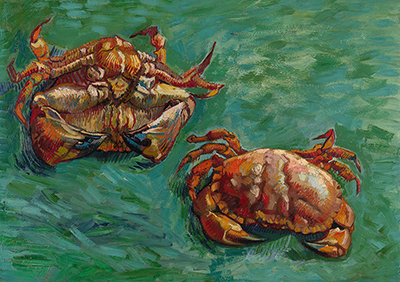Vincent van Gogh's still life study, Two Crabs, is an intriguing oil on canvas measuring nineteen by twenty-four inches. The detail of the creatures is a departure from the careless, abstract style of much of his work.
The painting contains the bright, vibrant colours van Gogh preferred during his frenzied bouts of artistic activity prior to his death in 1890.
Two Crabs or One?
Although Two Crabs could be portraits of a single crab, each one is vastly different in size. The smaller crab sits towards the lower right of the canvas and is depicted in a natural position as seen from above.
A much larger crab is painted at the top left. It shows its underside, but the crab is evidently standing on its face in an unnatural, upright position. The two crabs could represent order and chaos, two sides of the same entity. They reflect the imbalance in van Gogh's personality, with the larger, chaotic crab being the more dominant.
Colour and Brushwork
The smaller crab's brushstrokes are smoothly applied with highlights of brilliant white and deeper tones on its left side to show the three-dimensional curvature of its moist, reflective shell. On the larger crab, the brushstrokes are more noticeable and hurriedly applied. They are mostly vertical and convey a disorderly image with splashes of greyish-blue and yellow.
The choice of vivid reddish-orange for the two crabs against a sea of turquoise shows van Gogh's great admiration for the work of Eugène Delacroix. In Two Crabs, van Gogh successfully demonstrates Delacroix's theory of opposing colours forming a complementary pair to heighten the intensity of each other.
Inspiration
Two Crabs was painted in Arles in 1889 during van Gogh's phase of renewed enthusiasm for art following his nervous collapse of the previous year. He could have painted Two Crabs as early as January 1889 as on the seventh, he wrote to his brother, Theo, that he was about to embark on several still life studies. Van Gogh's love of Oriental woodcuts is well-known and his inspiration may have been the work of Hokusai.
The Japanese artist's delicate watercolour, Crabs, which depicts two lively crabs of different sizes, was featured in a magazine Theo had forwarded to him eight months earlier. Van Gogh evidently continued his experiment with colourful crabs as another painting entitled Crab on its Back, displayed at the van Gogh Museum in Amsterdam, is believed to have been painted at the same time.




